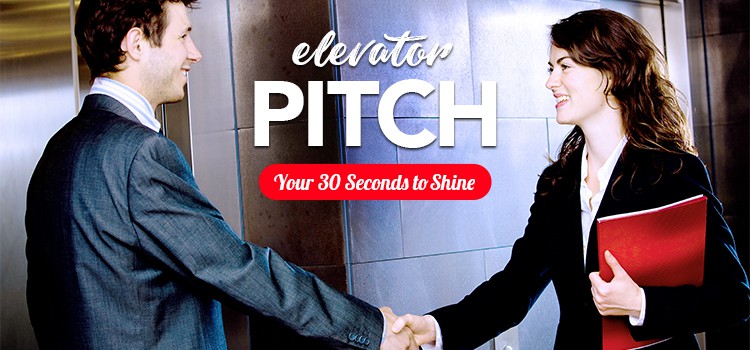You’re walking into an elevator at a networking event and run into a CEO or an investor you’ve been trying to connect with all day, how do you break the ice? If you don’t have a convincing pitch prepared that lasts the amount of time you have in that elevator ride, then you’re in a pickle.
From now on, make yourself a promise that you’ll never be without your Elevator Pitch. An elevator pitch is exactly what it sounds like. It’s a 20-30 second pitch meant to sell you and your company, all while catching the interest of your prospect.
A modern day entrepreneur is faced with a lot of challenges, like heavy competition. You can tire out all the different ways there are to stay ahead of your competitors, but nothing will ever be as powerful as the punch in your elevator pitch.
The following are all the steps you can take to craft a pitch that you will have mentally prepared for any situation with a CEO or important colleague.
Start on a Powerful Note
The first challenge is grasping your target’s attention so they don’t shake you off or give you the old “sorry I have to run” or “I don’t have time” excuse. To keep this from happening, stay casual and start your pitch with a hook. A hook is meant to grab attention right away. It can begin with a question, but the two things that should always be apparent is the problem and the solution, or in other words, a value proposition.
It makes a world of difference to create a value proposition that have strong driving forces. For instance, mention the exclusivity, appeal, and credibility of your product. Slipping in references to other well-known brands will make you more credible and trustworthy. For example, if you have a product that is Apple certified or Amazon certified, then customers will be more likely to trust your products or service.
Things to keep in mind when creating your intro:
- Don’t catch your prospect off guard with jargon, use language that will draw your listener in.
- Make sure you selling point has do to with your industry, not your product. That way you won’t sound like a common salesman.
- Be so specific that you clearly solve the problem at hand. You are on a time limit, after all, so get right to the point.
Before you craft your value proposition, check these off your list:
- Know your customer and think from their perspective.
- Know your product and services inside and out.
- Know your competition. What differentiates you?
- Know the benefits to your offering.
To get a clear idea what we mean, below are a few examples of how to kick off your elevator pitch:
- “Don’t you hate it when you’re the only person with no cell phone service?”
- “Is your business doing better than it was 2 years ago?”
Steve Jobs famously convinced John Scully, the ex-president of Pepsi, to leave Pepsi with a high punch elevator speech that started off like this: “Do you want to spend the rest of your life selling sugared water, or do you want a chance to change the world?”
The key component to what Jobs said is that he focused on the listener rather than Apple. You should recruit similar tactics when crafting your pitch if you want to draw your listener in.
Identify Your Target Market
Before you begin writing your pitch, you need to know who you’re writing it for. Illustrate who your target customer is so that you pitch to the right people. This will save you both time and energy (and probably money!)
As a business, you’ve probably already studied who your competition is, so half of your homework should already be done. Knowing your competition will help you have an edge on what your listener may have already heard or been offered.
If you’re trying to target literally anyone, then have a genuine passion for what you’re selling, because you are selling yourself, not just your product.
Choose Your Words Wisely
The words you choose should reflect the overall tone of your elevator speech. The tone should be natural and not rehearsed, because this is a natural interaction you’re engaging in. Using robotic or complicated words will disinterest your listener due to lack of ingenuity. If your listener doesn’t understand the words you’re using, your time is completely wasted and you may lose business.
Complicated words to avoid include: jargon, technical terms and industry buzz words.
Example words/phrases to avoid, by industry –
- Corporate: “Bang For a Buck”, “Due Diligence” , “9-5”, “Moving forward”, “Think outside-the-box”, “Pushing the envelope”, “Win-win situation”
- Political: “Liberals”, “Dems”, “Left Wing”, “Right Wing”, “POTUS”
- Marketing: “Best practices”, “Customer centric”, “ROI (Return On Investment)”, “Storytelling”, “Viral”
Now that you know what type of words you shouldn’t use, you should have no problem writing a clear and concise pitch that clearly proves that there’s a demand for what you are providing.
Write your pitch and practice it over and over until every word you use has a purpose, however when the time comes, make sure your practiced words remain both conversational and professional. Nothing scares someone away like sounding like you’re reading from a prompt!
End it With a Strong Call-To-Action
If you’re stuck on the ending of your pitch, we’ll make it easy for you – end it with a call-to-action! Give them a reason to follow through with you.
A call-to-action is also an unavoidable conversation starter, so your 20 second speech can suddenly turn into a casual conversation and exchanging of info!
Don’t hesitate to end your speech with a question if you started it with a question, too. Asking questions, in this instance, urge your listener to think about what you are saying, meaning they won’t get distracted or lose interest.
Examples of calls-to-action:
- Ask them to download and try out your app for free or for a discount on products.
- Ask them if they want to set up a meeting.
- “If you’re interested in learning more, I’d love to stop by your office and give you a live demo, does that work?”
Reiterate Your Pitch Through Different Marketing Materials
Your pitch isn’t the “end all be all” of the conservation. Always have your essential marketing materials on you so that you have something to give out after your pitch. Your marketing materials can include a business card, postcard or brochure that outlines your brand in more detail.
A business card is the easiest marketing material to carry around and most efficient. Not only is it the perfect pocket size, but it also holds your contact information on one side, while reiterating your pitch and branding message on the other side.
Other pertinent information on your marketing materials, such as your website, will enforce message consistency. By having solid proof that can back up what you said in your pitch, people will be more willing to trust you and your brand, and in result establishing contact.
Elevator Pitch Examples
- “Let’s face it. Parking can be a real nightmare. It can be infuriating to find, extremely pricey and by the time you find that spot you would have lost time, petrol, and caused a lot of unnecessary traffic and pollution. Well, there’s an answer, parkatmyhouse.com. We are an awesome little company, backed by an awesome big company called BMW. Now, listen in: You can reserve parking in a private property and save up to 70%. Need to park at a sports match or local station? Sorted. Just go to parkatmyhouse.com and simply type in where you want to park and what dates. It is that simple.” – JustPark1
- “My co-founders and I founded Grasshopper and Engine Yard, in which Amazon, Benchmark, and NEA invested. Our new company, Chargify, is a simple recurring billing management tool. We’re looking for angel capital to fill in some gaps. Maybe you’re interested in such an investment?” – Lance Walley, CEO of Chargify2
- “Pressed is an intelligent personal assistant designed to keep people focused on whatever goals they have; like working out, eating healthier, or even just drinking more water. Want to run a 5k? Pressed will learn that your office isn’t the place to remind you to train. However, it may notice you’ve been at home for a while and may have the time to get out there and break a sweat.” – Matt Bremerkamp from Pressed, a time management app.3
- Check out this video of Tesla CEO Elon Musk giving an elevator pitch to find inspiration when crafting your own speech.
What key elements have worked for you in an elevator pitch? Share with us in the comments!
1- https://slidebean.com/blog/startups/elevator-pitch-examples
2- https://smepals.com/startup/elevator-pitch-examples-worked-real-world
3- https://smepals.com/startup/elevator-pitch-examples-worked-real-world




